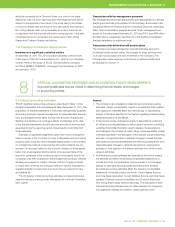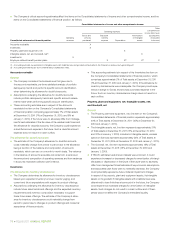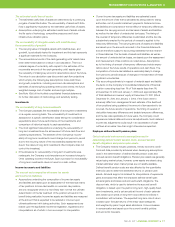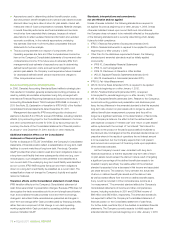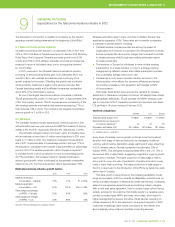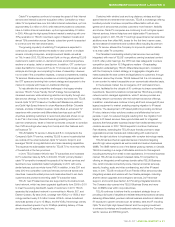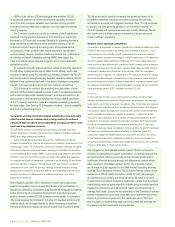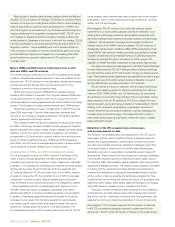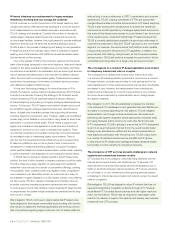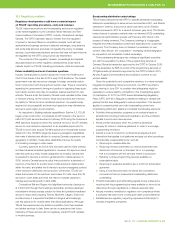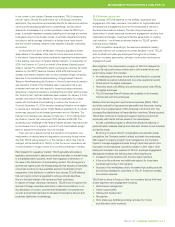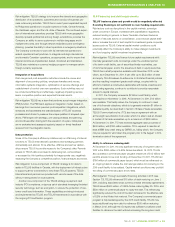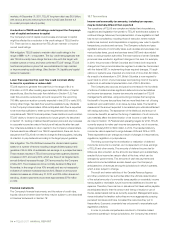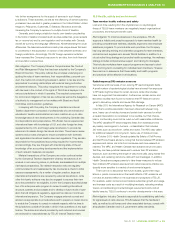Telus 2011 Annual Report Download - page 89
Download and view the complete annual report
Please find page 89 of the 2011 Telus annual report below. You can navigate through the pages in the report by either clicking on the pages listed below, or by using the keyword search tool below to find specific information within the annual report.
TELUS 2011 ANNUAL REPORT . 85
MANAGEMENT’S DISCUSSION & ANALYSIS: 10
Consumer
In the consumer wireline market, cable-TV companies and other
competitors encounter minimal regulation and continue to combine a
mix of residential local VoIP, long distance, HSIA and, in some cases,
wireless services into one bundled and/or discounted monthly rate, along
with their existing broadcast or satellite-based TV services. In addition,
cable-TV companies continue to increase the speed of their HSIA
offerings. To a lesser extent, other non-facilities-based competitors offer
local and long distance VoIP services over the Internet and resell HSIA
solutions. Erosion of TELUS’ residential NALs is expected to con tinue
as
a result of this competition, as well as ongoing technological and
wireless substitution. Competitors are expected to capture a majority
of the share in growth marketplace opportunities; therefore, access
line associated revenues, including long distance, can be expected to
continue to decline. Although the HSIA market is maturing, subscriber
growth is expected to continue over the next several years. With a
more mature HSIA market and the potential for higher-speed Internet
service offerings from competitors, TELUS may be constrained in its
ability to maintain market share in its incumbent territories by the
amount and timing of capital expenditures associated with maintaining
competitive network access speeds.
Risk mitigation in the consumer wireline market: TELUS continues to
expand the coverage and increase the speed of its high-speed Internet
service and increase the coverage and capability of its IP-based
Optik TV service in its incumbent territories (see Broadcasting below
and Section 2.2 Strategic imperatives). The provision of Optik TV service
helps the Company attract pull-through Internet subscriptions and
generally counter cable-TV competition in its incumbent markets, and
to retain and grow revenues with a bundled offering of local and long
distance telephony, HSIA and TV entertainment services. TELUS Satellite
TV service in Alberta and B.C. complements IP TV service, enabling
the Company to more effectively serve households that are not currently
on the TELUS IP TV network footprint and leverage TELUS’ strong
distribution and marketing presence. TELUS Satellite TV service is made
possible by an agreement with Bell Canada.
Broadcasting
As noted above, the Company offers TELUS TV in B.C., Alberta and
Eastern Quebec, and continues targeted roll-outs of Optik TV to new
areas. While TELUS TV provides numerous interactivity and customization
advantages, there can be no assurance that TELUS will be successful
in achieving its plans of obtaining a sizable share of the TV services
market or that implementation costs or projected TV revenues will be
as planned.
Risk mitigation: Fully digital TELUS TV is offered as both an IP-based
service (in urban markets of B.C., Alberta and Eastern Quebec) and a
satellite-based service (in B.C. and Alberta). TELUS broadened the
addressable market for its high-definition (HD) TV services through the
deployment of ADSL2+ technology and upgrades to VDSL2 technology.
In February 2010, TELUS launched an upgrade of its IP TV middleware
to next generation Microsoft Mediaroom. These developments enabled
the Company’s June 2010 launch of the Optik brand, featuring a suite
of advanced TV and high-speed Internet services, and facilitated a 62%
expansion in TELUS’ TV subscriber base in 2011.
Increasing vertical integration into broadcast content
ownership by competitors
TELUS is not currently seeking to be a broadcast content owner, but
several competitors have acquired broadcast content assets. Shaw
Communications acquired Canwest Global in 2010 and BCE acquired
the programming services of CTVglobemedia in 2011. Rogers Commu-
nications and Quebecor also own content assets. Increased vertical
integration could result in content being withheld from TELUS or being
made available at inflated prices.
Risk mitigation: TELUS’ strategy is to aggregate, integrate and
make accessible content and applications for customers’ enjoyment.
The Company does not believe it is necessary to own content to make
it accessible to customers on an economically attractive basis. It is
not clear that any positive synergies of ownership for carriers outweigh
negative synergies of limiting audiences through exclusive arrangements
and negative impacts on other supplier relationships. TELUS believes
that regulatory safeguards introduced by the CRTC in 2011 are needed
(see Section 10.3 Regulatory matters). However, these safeguards
may not prove to be fully effective.
10.2 Technology
Technology is a key enabler for TELUS and its customers. However,
technology evolution brings risks, uncertainties and opportunities.
TELUS is vigorous in maintaining its short-term and long-term technology
strategy to optimize the Company’s selection and timely use of tech-
nology, while minimizing the associated costs, risks and uncertainties.
The following identifies the main technology risks and uncertainties
and how TELUS is proactively addressing them.
Subscriber demand for data may challenge wireless networks
and is expected to be accompanied by decreasing prices
The demand for wireless data services has been growing at unprece-
dented rates and it is projected that this growth will continue to accelerate,
driven by increases in the following: broadband penetration, the need
for personal connectivity and networking, affordability of smartphones
and high-usage data devices (such as smartphones, mobile Internet
keys and tablets), machine-to-machine data applications, richer multi-
media services and applications, and wireless price competition. Given
the highly competitive wireless business environment in Canada, it is
expected that wireless data revenues will grow more slowly than demand
for bandwidth. Increasing data traffic levels and an accelerating pace
in data device innovation present a growing challenge to adequately
provision capacity and to maintain high service levels.
Risk mitigation: TELUS built an extensive wireless network based
on HSPA+ technologies (including HSPA+ dual-cell) and expects to
implement further standards-based enhancements that are ready
for commercial deployment. The HSPA+ network positions TELUS
to meet capacity demands and challenges in the near future.
In addition to the superior capabilities and higher capacity delivered
by HSPA+, TELUS’ investments in IP networks, IP/fibre cell-site
back haul and a software-upgradeable radio infrastructure facilitated
the launch of LTE-based services in February 2012 and will support
the future evolution to LTE-advanced technologies. LTE is expected
to further increase network capacity and speed, reduce delivery costs
per megabyte of data, enable richer multimedia applications and
services, and deliver a superior subscriber experience. LTE delivers
peak manufacturer-rated download speeds of up to 75 Mbps
(typical speeds of 12 to 25 Mbps expected).


